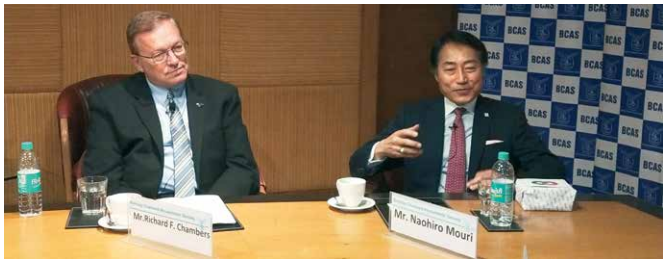INTRODUCTION
The Hindu Succession
(Amendment) Act, 2005 (‘2005 Amendment Act’) which was made operative from 9th
September, 2005, was a path-breaking Act which placed Hindu daughters on an
equal footing with Hindu sons in their father’s Hindu Undivided Family by
amending the age-old Hindu Succession Act, 1956 (‘the Act’). However, while it
ushered in great reforms it also left several unanswered questions and
ambiguities. Key amongst them was to which class of daughters did the 2005
Amendment Act apply? The Supreme Court by two important decisions had answered
some of these questions and helped clear a great deal of confusion. However,
just when one thought that things had been settled, a larger bench of the Apex
Court has turned the decision on its head and come out with a more liberal
interpretation of the law. Let us analyse the Amendment and the old and the new
decisions to understand the situation in greater detail.
THE 2005 AMENDMENT ACT
First, let us understand
the Amendment to put the issue in perspective. The Hindu Succession (Amendment)
Act, 2005 amended the Hindu Succession Act, 1956 which is one of the few
codified statutes under Hindu Law. It applies to all cases of intestate succession
by Hindus. The Act applies to Hindus, Jains, Sikhs, Buddhists and to any person
who is not a Muslim, a Christian, a Parsi or a Jew. Any person who becomes a
Hindu by conversion is also covered by the Act. The Act overrides all Hindu
customs, traditions and usages and specifies the heirs entitled to such
property and the order or preference among them. The Act also deals with some
important aspects pertaining to an HUF.
By the 2005 Amendment Act,
Parliament amended section 6 of the Hindu Succession Act, 1956 and the amended
section was made operative from 9th September, 2005. Section 6 of
the Hindu Succession Act, 1956 was totally revamped. The relevant portion of
the amended section 6 is as follows:
‘6. Devolution of interest
in coparcenary property.?(1) On and from the commencement of the Hindu
Succession (Amendment) Act, 2005 (39 of 2005), in a Joint Hindu family governed
by the Mitakshara law, the daughter of a coparcener shall,?
(a) by birth become a
coparcener in her own right in the same manner as the son;
(b) have the same rights
in the coparcenary property as she would have had if she had been a son;
(c) be subject to the same
liabilities in respect of the said coparcenary property as that of a son, and
any reference to a Hindu Mitakshara coparcener shall be deemed to include a
reference to a daughter of a coparcener:
Provided that nothing
contained in this sub-section shall affect or invalidate any disposition or
alienation including any partition or testamentary disposition of property
which had taken place before the 20th day of December, 2004.’
Thus, the amended section
provides that a daughter of a coparcener shall become by birth a coparcener in
her own right in the same manner as the son and, further, she shall have the
same rights in the coparcenary property as she would have had if she had been a
son. It also provides that she shall be subject to the same liabilities in
respect of the coparcenary property as a son. Accordingly, the amendment
equated all daughters with sons and they would now become coparceners in their
father’s HUF by virtue of being born in that family. She has all rights and
obligations in respect of the coparcenary property, including testamentary
disposition. Not only would she become a coparcener in her father’s HUF, but
she could also make a will for the same.
One issue which remained
unresolved was whether the application of the amended section 6 was prospective
or retrospective?
Section 1(2) of the Hindu
Succession (Amendment) Act, 2005, stated that it came into force from the date
it was notified by the Government in the Gazette, i.e., 9th
September, 2005. Thus, the amended section 6 was operative from that date.
However, did this mean that the amended section applied to:
(a) daughters born after
that date,
(b) daughters married
after that date, or
(c) all daughters, married
or unmarried, but living as on that date?
There was no clarity under
the Act on this point.
PROSPECTIVE APPLICATION UPHELD
The Supreme Court, albeit
in a different context, clarified that the 2005 Amendment Act did not seek to
reopen vesting of a right where succession has already taken place. According
to the Supreme Court, ‘the operation of the Statute is no doubt prospective
in nature… the 2005 Act is not retrospective, its application is prospective” –
G. Sekar vs. Geetha (2009) 6 SCC 99.
The Supreme Court has held
in Sheela Devi vs. Lal Chand, (2007) 1 MLJ 797 (SC) that if the
succession was opened prior to the Hindu Succession (Amendment) Act, 2005, the
provisions of the 2005 Amendment Act would have no application.
FATHER-DAUGHTER COMBINATION IS A MUST
Finally, the matter was
settled by a two-Judge Bench of the Apex Court in its decision in the case of Prakash
vs. Phulavati, (2016) 2 SCC 36. The Supreme Court examined the issue in
detail and held that the amendment was prospective and not retrospective. It
further held that the rights under the Hindu Succession Act Amendment were
applicable to living daughters of living coparceners (fathers) as on 9th
September, 2005 irrespective of when such daughters were born. It further held
that any disposition or alienation including a partition of the HUF which may
have taken place before 20th December, 2004 (the cut-off date
provided under the 2005 Amendment Act) as per law applicable prior to the said
date, would remain unaffected. Thus, as per the above Supreme Court decision,
in order to claim benefit what was required was that the daughter should be
alive and her father should also be alive on the date of the amendment, i.e., 9th
September, 2005. Once this condition was met, it was immaterial whether the
daughter was married or unmarried. The Court had also clarified that it was
immaterial when the daughter was born.
DAUGHTER BORN BEFORE THE ACT
In Danamma @ Suman
Surpur & Anr. vs. Amar & Ors., (2018) 3 SCC 343, another
two-Judge Bench of the Supreme Court took off from the Prakash case
(Supra) and agreed with it. It held that the Amendment used the words ‘in
the same manner as the son’. It was therefore apparent that both the sons
and the daughters of a coparcener had been conferred the right of becoming
coparceners by birth. It was the very factum of birth in a coparcenary that
created the coparcenary, therefore the sons and daughters of a coparcener
became coparceners by virtue of birth. The net effect of the amendment
according to the Court was that it applied to living daughters of living
coparceners as on 9th September, 2005. It did not matter whether the
daughters were married or unmarried. It did not matter when the daughters were
born. They might be born even prior to the enactment of the 1956 Act, i.e., 17th
June, 1956.
THREE-JUDGE VERDICT LAYS DOWN A NEW LAW
A three-Judge Bench of the
Supreme Court in the case of Vineeta Sharma vs. Rakesh Sharma, CA 32601
/2018, Order dated 11th August, 2020 considered a bunch of
SLPs before it on the issue of the 2005 Amendment Act. The Court by a very
detailed verdict considered the entire genesis of the HUF Law. It held that in
the Mitakshara School of Hindu law (applicable to most parts of India), in a coparcenary
there is unobstructed heritage, i.e., right is created by birth. When right is
created by birth it is called unobstructed heritage. At the same time, the
birthright is acquired in the property of the father, grandfather, or great
grandfather. In case a coparcener dies without leaving a son, right is acquired
not by birth, but by virtue of there being no male issue and is called
obstructed heritage. It is called obstructed because the accrual of right to it
is obstructed by the owner’s existence. It is only on his death that obstructed
heritage takes place. It held that property inherited by a Hindu from his
father, father’s father, or father’s grandfather (but not from his maternal
grandfather) is unobstructed heritage as regards his own male issues, i.e., his
son, grandson, and great-grandson. His male issues acquire an interest in it
from the moment of their birth. Their right to it arises from the mere fact of
their birth in the family, and they become coparceners with their paternal
ancestor in such property immediately on their birth, and in such cases
ancestral property is unobstructed heritage.
Further, any property, the
right to which accrues not by birth but on the death of the last owner without
leaving a male issue, is called obstructed heritage. It is called obstructed
because the accrual of right to it is obstructed by the existence of the owner.
Consequently, property which devolves on parents, brothers, nephews, uncles,
etc. upon the death of the last owner is obstructed heritage. These relations
do not have a vested interest in the property by birth. Their right to it
arises for the first time on the death of the owner. Until then, they have a
mere spes successionis, or a bare chance of succession to the property,
contingent upon their surviving the owner. Accordingly, the Apex Court held
that unobstructed heritage took place by birth and obstructed heritage took
place after the death of the owner.
The Apex Court laid down a
very vital principle that coparcenary right, under section 6 (including
after Amendment), is given by birth which is called unobstructed heritage.
It is not a case of obstructed heritage depending upon the owner’s death. Thus,
the Supreme Court concluded that a coparcener’s father need not be alive
on 9th September, 2005, i.e., the date of the Amendment.
The Court observed that
the Amendment was a gender bender inasmuch as it sought to achieve removing ‘gender
discrimination to a daughter who always remains a loving daughter’. It
further held that though the rights could be claimed, w.e.f. 9th
September, 2005, the provisions were of a retroactive application, i.e., they
conferred benefits based on the antecedent event and the Mitakshara coparcenary
law should be deemed to include a reference to a daughter as a coparcener.
Under the amended section 6, since the right was given by birth, i.e., an
antecedent event, the provisions concerning claiming rights operated on and
from the date of the Amendment Act. Thus, it is not at all necessary that the
father of the daughter should be living as on the date of the Amendment, as she
has not been conferred the rights of a coparcener by obstructed heritage. The
effect of the amendment is that a daughter is made coparcener with effect from
the date of the amendment and she can claim partition also, which is a
necessary concomitant of the coparcenary. Section 6(1) recognises a joint Hindu
family governed by Mitakshara Law. The coparcenary must exist on 9th
September, 2005 to enable the daughter of a coparcener to enjoy rights
conferred on her. As the right is by birth and not by dint of inheritance, it
is irrelevant whether a coparcener whose daughter is conferred with the rights
is alive or not. Conferral is not based on the death of a father or other
coparcener.
The Court also held that
the daughter should be living on 9th September, 2005. In the
substituted section 6, the expression ‘daughter of a living coparcener’ has not
been used. One corollary to this explanation would mean that if the daughter
has died before this date, then her children cannot become coparceners in their
maternal grandfather’s HUF. However, if she dies on or after this date, then
her children can become coparceners in their maternal grandfather’s HUF.
The Court explained one of
the implications of becoming a coparcener was that a daughter has now become
entitled to claim partition of coparcenary w.e.f. 9th September,
2005, which was a vital change brought about by the statute. Accordingly, the
Supreme Court in Vineeta Sharma vs. Rakesh Sharma, CA 32601/2018, Order
dated 11th August, 2020 expressly overturned its earlier
verdict in Prakash vs. Phulavati, (2016) 2 SCC 36 and those
portions of Danamma @ Suman Surpur & Anr. vs. Amar & Ors., (2018)
3 SCC 343 which approved of the decision in Prakash vs. Phulavati.
EXCEPTION TO THE RULE
Section 6(5) of the Act
provides that the Amendment will not apply to an HUF whose partition has been
effected before 20th December, 2004. For this purpose, the partition
should be by way of a registered partition deed / a partition brought out by a
Court Decree. In the Amendment Bill even oral partitions, supported by
documentary evidence, were allowed. However, this was dropped at the final
stage since the intention was to avoid any sham or bogus transactions in order
to defeat the rights of coparcener conferred upon daughters by the 2005
Amendment Act.
It was argued before the
Court that the requirement of a registered deed was only directory and not
mandatory. But the Court negated this argument. It held that the intent of the
provisions was not to jeopardise the interest of the daughter but to take care
of sham or frivolous transactions set up in defence unjustly to deprive the
daughter of her right as coparcener. In view of the clear provisions of section
6(5), the intent of the Legislature was clear and a plea of oral partition was
not to be readily accepted. However, in exceptional cases where the plea of
oral partition was supported by public documents and partition was finally
evinced in the same manner as if it had been effected by a decree of a court,
it may be accepted. A plea of partition based on oral evidence alone could not
be accepted and had to be rejected outright.
CONCLUSION
The conclusion arrived at
by the Supreme Court in Vineeta Sharma’s case (Supra) undoubtedly
appears to be correct as compared to the earlier decisions on the point. A
beneficial Amendment was sought to be made restrictive and the same has now
been set right. However, consider the turmoil and the legal complications which
this decision would now create. Several disputes in HUFs were created by the
2005 Amendment and those raging fires were settled by the decision in Prakash
vs. Phulavati (Supra). It has been almost five years since this
decision was rendered. Now comes a decision which overrules the settled law.
One can expect a great deal of litigation on this issue now that the
restrictive parameters set down have been removed. In respect of cases pending
before different High Courts and subordinate courts, the Supreme Court in Vineeta
Sharma’s case (Supra) has held that daughters cannot be deprived of
their equal right and hence it requested that all the pending matters be
decided, as far as possible, within six months. However, what happens to cases
where matters are settled? Would they be reignited again?
One wonders
how Parliament can enact such a path-breaking enactment and not pay heed to a
simple matter of its date of applicability. Could this issue not have been
envisaged at the drafting stage? This is a classic case of a very advantageous
and laudable Amendment suffering from inadequate drafting! Is it not strange
that while the language of some of our pre-Independence Acts (such as the
Contract Act 1872, Transfer of Property Act 1882, Indian Succession Act 1925,
etc.) have stood strong for over a century, some of our recent statutes have
suffered on the drafting front. Ultimately, matters have to travel to the
Supreme Court leading to a lot of wastage of time and money. One can only hope
that this issue of the coparcenary right of a daughter in her father’s
HUF is settled once and for all. Or are there going to be some more
twists in this tale?
If you disrupt yourself, you
will be able to manage and even thrive through disruption.
—
Whitney Johnson, Executive Coach and Author











